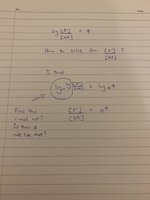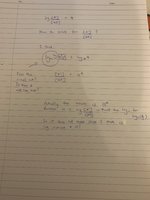You are using an out of date browser. It may not display this or other websites correctly.
You should upgrade or use an alternative browser.
You should upgrade or use an alternative browser.
Logarithm Problem
- Thread starter Amelia Hu
- Start date
- Joined
- Nov 24, 2012
- Messages
- 3,021
Hello, and welcome to FMH! 
I am unclear what "A-" means...can you post a pic of the original equation, or format it more clearly? For example, I am unsure whether the exponent on the left side is:
[MATH]\frac{\log(A-)}{HA}[/MATH]
or:
[MATH]\log\left(\frac{A-}{HA}\right)[/MATH]
Also, are we to solve for \(A\) or \(H\)?
I am unclear what "A-" means...can you post a pic of the original equation, or format it more clearly? For example, I am unsure whether the exponent on the left side is:
[MATH]\frac{\log(A-)}{HA}[/MATH]
or:
[MATH]\log\left(\frac{A-}{HA}\right)[/MATH]
Also, are we to solve for \(A\) or \(H\)?
Hello, Thanks! 
It's [MATH]\log\left(\frac{A-}{HA}\right)[/MATH] . So are to solve (A-)/(HA) together ? I thought of putting log10 on both sides. I do not know if log10 to the power of [MATH]\log\left(\frac{A-}{HA}\right)[/MATH], does the log10 and the log cancel out to be just (A-)/(HA) and the other side log10 to the power of 4 will be converted to the exponential which is 10 to the power of 4? Is that so that there is a rule of log10 and the log cancel out to be just (A-)/(HA)? Then (A-)/(HA) is (10 to the power of 4 ) over 1. Thanks. Do hear from you soon.
It's [MATH]\log\left(\frac{A-}{HA}\right)[/MATH] . So are to solve (A-)/(HA) together ? I thought of putting log10 on both sides. I do not know if log10 to the power of [MATH]\log\left(\frac{A-}{HA}\right)[/MATH], does the log10 and the log cancel out to be just (A-)/(HA) and the other side log10 to the power of 4 will be converted to the exponential which is 10 to the power of 4? Is that so that there is a rule of log10 and the log cancel out to be just (A-)/(HA)? Then (A-)/(HA) is (10 to the power of 4 ) over 1. Thanks. Do hear from you soon.
Hi, thanks. It's actually a chemistry question, so it is the ratio of A− (ionized) to HA (unionized) and I'm supposed to find the the ratio of A− (ionized) to HA (unionized). I'm just thinking of the mathematics part of log10 to the power of [MATH]\log\left(\frac{A^-}{H_A}\right)[/MATH] , does the log10 and the log cancel out to be just (A-)/(HA) ?
Last edited by a moderator:
Harry_the_cat
Elite Member
- Joined
- Mar 16, 2016
- Messages
- 3,779
If \(\displaystyle log_{10}A = log_{10}B\) then \(\displaystyle A=B\). Does that help?how to solve log 10 to the power of log (A-)/(HA) = log10 to the power of 4? Thanks
HallsofIvy
Elite Member
- Joined
- Jan 27, 2012
- Messages
- 7,760
Okay, so "H-" and "HA" are just numbers that we could as well call "x" and "y" (for the non-chemists among us). And you are asking about \(\displaystyle log\left(\frac{x}{y}\right)\)?
But I am still not clear on what you mean by "log 10 to the power of". Do "logarithm to base 10" of "logarithm of 10"?
If you just mean "\(\displaystyle log\left(\frac{H-}{HA}\right)= -4\)" (the logarithm of \(\displaystyle 10^{-4}\) is just -4) then use the fact that \(\displaystyle log\left(\frac{H-}{HA}\right)= log(H-)- log(HA)= -4\) so that log(H-)= log(HA)- 4 or, equivalently, that log(HA)= log(H-)+ 4.
But I am still not clear on what you mean by "log 10 to the power of". Do "logarithm to base 10" of "logarithm of 10"?
If you just mean "\(\displaystyle log\left(\frac{H-}{HA}\right)= -4\)" (the logarithm of \(\displaystyle 10^{-4}\) is just -4) then use the fact that \(\displaystyle log\left(\frac{H-}{HA}\right)= log(H-)- log(HA)= -4\) so that log(H-)= log(HA)- 4 or, equivalently, that log(HA)= log(H-)+ 4.
[MATH]log_{10} \left ( \dfrac{x}{y} \right ) = 4 = 4 * 1 = 4 * log_{10}(10) = log_{10}(10^4) \implies[/MATH]
[MATH]\dfrac{x}{y} = 10^4 = 10,000.[/MATH]
The above takes advantage of three laws of logs.
[MATH]log_a(a) = 1.[/MATH]
[MATH]b * log_a(c) = log_a(c^b).[/MATH]
[MATH]log_a(x) = log_a(y) \implies x = y.[/MATH]
[MATH]\dfrac{x}{y} = 10^4 = 10,000.[/MATH]
The above takes advantage of three laws of logs.
[MATH]log_a(a) = 1.[/MATH]
[MATH]b * log_a(c) = log_a(c^b).[/MATH]
[MATH]log_a(x) = log_a(y) \implies x = y.[/MATH]
Hi, thanks a lot. You're right. The text has some printing error , so it's log10 (x/y). It's solvedHi, thanks a lot. But then to be exact, it is not log 10 ( x / y ), it is more of log ( x/y). Does it in this does not make sense?
Last edited by a moderator:


